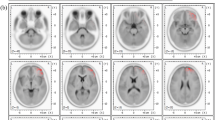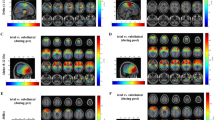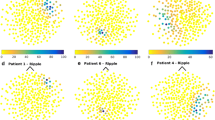Abstract
Aberrant brain activity in childhood absence epilepsy (CAE) during seizures has been well recognized as synchronous 3 Hz spike-and-wave discharges on electroencephalography. However, brain activity from low- to very high-frequency ranges in subjects with CAE between seizures (interictal) has rarely been studied. Using a high-sampling rate magnetoencephalography (MEG) system, we studied ten subjects with clinically diagnosed but untreated CAE in comparison with age- and gender-matched controls. MEG data were recorded from all subjects during the resting state. MEG sources were assessed with accumulated source imaging, a new method optimized for localizing and quantifying spontaneous brain activity. MEG data were analyzed in nine frequency bands: delta (1–4 Hz), theta (4–8 Hz), alpha (8–12 Hz), beta (12–30 Hz), low-gamma (30–55 Hz), high-gamma (65–90 Hz), ripple (90–200 Hz), high-frequency oscillation (HFO, 200–1,000 Hz), and very high-frequency oscillation (VHFO, 1,000–2,000 Hz). MEG source imaging revealed that subjects with CAE had higher odds of interictal brain activity in 200–1,000 and 1,000–2,000 Hz in the parieto-occipito-temporal junction and the medial frontal cortices as compared with controls. The strength of the interictal brain activity in these regions was significantly elevated in the frequency bands of 90–200, 200–1,000 and 1,000–2,000 Hz for subjects with CAE as compared with controls. The results indicate that CAE has significantly aberrant brain activity between seizures that can be noninvasively detected. The measurements of high-frequency neuromagnetic oscillations may open a new window for investigating the cerebral mechanisms of interictal abnormalities in CAE.




Similar content being viewed by others
References
Amor F, Baillet S, Navarro V, Adam C, Martinerie J, Quyen Mle V (2009) Cortical local and long-range synchronization interplay in human absence seizure initiation. Neuroimage 45(3):950–962
Bai X, Guo J, Killory B, Vestal M, Berman R, Negishi M, Danielson N, Novotny EJ, Constable RT, Blumenfeld H (2011) Resting functional connectivity between the hemispheres in childhood absence epilepsy. Neurology 76(23):1960–1967
Bragin A, Wilson CL, Almajano J, Mody I, Engel J Jr (2004) High-frequency oscillations after status epilepticus: epileptogenesis and seizure genesis. Epilepsia 45(9):1017–1023
Brookes MJ, Stevenson CM, Barnes GR, Hillebrand A, Simpson MI, Francis ST, Morris PG (2007) Beamformer reconstruction of correlated sources using a modified source model. Neuroimage 34(4):1454–1465
Caraballo RH, Darra F, Fontana E, Garcia R, Monese E, Dalla Bernardina B (2011) Absence seizures in the first 3 years of life: an electroclinical study of 46 cases. Epilepsia 52(2):393–400
Ebersole JS, Ebersole SM (2010) Combining MEG and EEG source modeling in epilepsy evaluations. J Clin Neurophysiol 27(6):360–371
Engel J Jr, da Silva FL (2012) High-frequency oscillations—where we are and where we need to go. Prog Neurobiol 98(3):316–318
Engel J Jr, Bragin A, Staba R, Mody I (2009) High-frequency oscillations: what is normal and what is not? Epilepsia 50(4):598–604
Epilepsy CoCaTotILA (1989) Proposal for revised classification of epilepsies and epileptic syndromes. Commission on Classification and Terminology of the International League against Epilepsy. Epilepsia 30(4):389–399
Fischer MJ, Rampp S, Scheler G, Stefan H (2008) A systematic review on MEG and its use in the presurgical evaluation of localization-related epilepsy. Epilepsy Res 82(2–3):238–239 author reply 240–231
Glauser TA, Cnaan A, Shinnar S, Hirtz DG, Dlugos D, Masur D, Clark PO, Capparelli EV, Adamson PC, Childhood Absence Epilepsy Study G (2010) Ethosuximide, valproic acid, and lamotrigine in childhood absence epilepsy. N Engl J Med 362(9):790–799
Gotman J (2010) High frequency oscillations: the new EEG frontier? Epilepsia 51(Suppl 1):63–65
Haegelen C, Perucca P, Chatillon CE, Andrade-Valenca L, Zelmann R, Jacobs J, Collins DL, Dubeau F, Olivier A, Gotman J (2013) High-frequency oscillations, extent of surgical resection, and surgical outcome in drug-resistant focal epilepsy. Epilepsia 54(5):848–857
Huang MX, Theilmann RJ, Robb A, Angeles A, Nichols S, Drake A, D’Andrea J, Levy M, Holland M, Song T, Ge S, Hwang E, Yoo K, Cui L, Baker DG, Trauner D, Coimbra R, Lee RR (2009) Integrated imaging approach with MEG and DTI to detect mild traumatic brain injury in military and civilian patients. J Neurotrauma 26(8):1213–1226
Hughes SW, Lorincz ML, Parri HR, Crunelli V (2011) Infraslow (<0.1 Hz) oscillations in thalamic relay nuclei basic mechanisms and significance to health and disease states. Prog Brain Res 193:145–162
Jacobs J, Staba R, Asano E, Otsubo H, Wu JY, Zijlmans M, Mohamed I, Kahane P, Dubeau F, Navarro V, Gotman J (2012) High-frequency oscillations (HFOs) in clinical epilepsy. Prog Neurobiol 98(3):302–315
Kerber K, Dumpelmann M, Schelter B, LeVan P, Korinthenberg R, Schulze-Bonhage A, Jacobs J (2014) Differentiation of specific ripple patterns helps to identify epileptogenic areas for surgical procedures. Clin Neurophysiol 125(7):1339–45
Killory BD, Bai X, Negishi M, Vega C, Spann MN, Vestal M, Guo J, Berman R, Danielson N, Trejo J, Shisler D, Novotny EJ Jr, Constable RT, Blumenfeld H (2011) Impaired attention and network connectivity in childhood absence epilepsy. Neuroimage 56(4):2209–2217
Lopes da Silva FH, Blanes W, Kalitzin SN, Parra J, Suffczynski P, Velis DN (2003) Dynamical diseases of brain systems: different routes to epileptic seizures. IEEE Trans Bio-Med Eng 50(5):540–548
Mariani E, Rossi LN, Vajani S (2011) Interictal paroxysmal EEG abnormalities in childhood absence epilepsy. Seizure 20(4):299–304
Menendez de la Prida L, Trevelyan AJ (2011) Cellular mechanisms of high frequency oscillations in epilepsy: on the diverse sources of pathological activities. Epilepsy Res 97(3):308–317
Miao A, Xiang J, Tang L, Ge H, Liu H, Wu T, Chen Q, Hu Z, Lu X, Wang X (2014) Using ictal high-frequency oscillations (80–500 Hz) to localize seizure onset zones in childhood absence epilepsy: a MEG study. Neurosci Lett 566:21–26
Moeller F, LeVan P, Muhle H, Stephani U, Dubeau F, Siniatchkin M, Gotman J (2010) Absence seizures: individual patterns revealed by EEG-fMRI. Epilepsia 51(10):2000–2010
Mullen SA, Suls A, De Jonghe P, Berkovic SF, Scheffer IE (2010) Absence epilepsies with widely variable onset are a key feature of familial GLUT1 deficiency. Neurology 75(5):432–440
Ogura K, Maegaki Y, Koeda T (2005) EEG evaluation of fixation-off sensitivity in eyelid myoclonia with absences. Pediatr Neurol 33(2):142–145
Ponten SC, Douw L, Bartolomei F, Reijneveld JC, Stam CJ (2009) Indications for network regularization during absence seizures: weighted and unweighted graph theoretical analyses. Exp Neurol 217(1):197–204
Rampp S, Stefan H (2007) Magnetoencephalography in presurgical epilepsy diagnosis. Expert Rev Med Devices 4(3):335–347
Richardson MP (2011) New observations may inform seizure models: very fast and very slow oscillations. Prog Biophys Mol Biol 105(1–2):5–13
Schubert R (2005) Attention deficit disorder and epilepsy. Pediatr Neurol 32(1):1–10
Sheth RD, Abram HS (2010) Absence epilepsy with focal clinical and electrographic seizures. Semin Pediatr Neurol 17(1):39–43
Sinclair DB, Unwala H (2007) Absence epilepsy in childhood: electroencephalography (EEG) does not predict outcome. J Child Neurol 22(7):799–802
Sohal VS (2012) Insights into cortical oscillations arising from optogenetic studies. Biol Psychiatry 71(12):1039–1045
Stacey WC, Krieger A, Litt B (2011) Network recruitment to coherent oscillations in a hippocampal computer model. J Neurophysiol 105(4):1464–1481
Stroganova TA, Orekhova EV, Prokofyev AO, Tsetlin MM, Gratchev VV, Morozov AA, Obukhov YV (2012) High-frequency oscillatory response to illusory contour in typically developing boys and boys with autism spectrum disorders. Cortex 48(6):701–717
Tenney JR, Fujiwara H, Horn PS, Jacobson SE, Glauser TA, Rose DF (2013) Focal corticothalamic sources during generalized absence seizures: a MEG study. Epilepsy Res 106(1–2):113–122
Uhlhaas PJ, Pipa G, Neuenschwander S, Wibral M, Singer W (2011) A new look at gamma? High- (>60 Hz) gamma-band activity in cortical networks: function, mechanisms and impairment. Prog Biophys Mol Biol 105(1–2):14–28
Urrestarazu E, Chander R, Dubeau F, Gotman J (2007) Interictal high-frequency oscillations (100–500 Hz) in the intracerebral EEG of epileptic patients. Brain 130(Pt 9):2354–2366
Vrba J, Robinson SE (2001) Signal processing in magnetoencephalography. Methods 25(2):249–271
Wood H (2011) High-frequency oscillations pinpoint the seizure-onset zone. Nat Rev Neurol 7(9):475
Worrell G, Gotman J (2011) High-frequency oscillations and other electrophysiological biomarkers of epilepsy: clinical studies. Biomark Med 5(5):557–566
Worrell GA, Jerbi K, Kobayashi K, Lina JM, Zelmann R, Le Van Quyen M (2012) Recording and analysis techniques for high-frequency oscillations. Prog Neurobiol 98(3):265–278
Xiang J, Liu Y, Wang Y, Kirtman EG, Kotecha R, Chen Y, Huo X, Fujiwara H, Hemasilpin N, Lee K, Mangano FT, Leach J, Jones B, DeGrauw T, Rose D (2009) Frequency and spatial characteristics of high-frequency neuromagnetic signals in childhood epilepsy. Epileptic Disord 11(2):113–125
Xiang J, Wang Y, Chen Y, Liu Y, Kotecha R, Huo X, Rose DF, Fujiwara H, Hemasilpin N, Lee K, Mangano FT, Jones B, DeGrauw T (2010) Noninvasive localization of epileptogenic zones with ictal high-frequency neuromagnetic signals. J Neurosurg Pediatr 5(1):113–122
Xiang J, Luo Q, Kotecha R, Korman A, Zhang F, Luo H, Fujiwara H, Hemasilpin N, Rose DF (2014) Accumulated source imaging of brain activity with both low and high-frequency neuromagnetic signals. Front Neuroinf 8(57):1–17
Yao B, Salenius S, Yue GH, Brown RW, Liu JZ (2007) Effects of surface EMG rectification on power and coherence analyses: an EEG and MEG study. J Neurosci Methods 159(2):215–223
Zijlmans M, Jiruska P, Zelmann R, Leijten FS, Jefferys JG, Gotman J (2012) High-frequency oscillations as a new biomarker in epilepsy. Ann Neurol 71(2):169–178
Acknowledgments
This study was partially supported by a Trustee Grant from Cincinnati Children’s Hospital Medical Center and Grant Number R21NS072817 from the National Institute of Neurological Disorders and Stroke (NINDS), the National Institutes of Health. Portions of this study were funded by a “Taking Flight” award from the Citizens United for Research in Epilepsy (CURE) (J.R.T.). We thank Ms. Hisako Fujiwara and Dr. Nat Hemasilpin for helping with MEG data acquisition. We thank all participants and their families for their time and support.
Conflict of interest
The authors have declared that no competing interests exist.
Author information
Authors and Affiliations
Corresponding author
Rights and permissions
About this article
Cite this article
Xiang, J., Tenney, J.R., Korman, A.M. et al. Quantification of Interictal Neuromagnetic Activity in Absence Epilepsy with Accumulated Source Imaging. Brain Topogr 28, 904–914 (2015). https://doi.org/10.1007/s10548-014-0411-5
Received:
Accepted:
Published:
Issue Date:
DOI: https://doi.org/10.1007/s10548-014-0411-5




